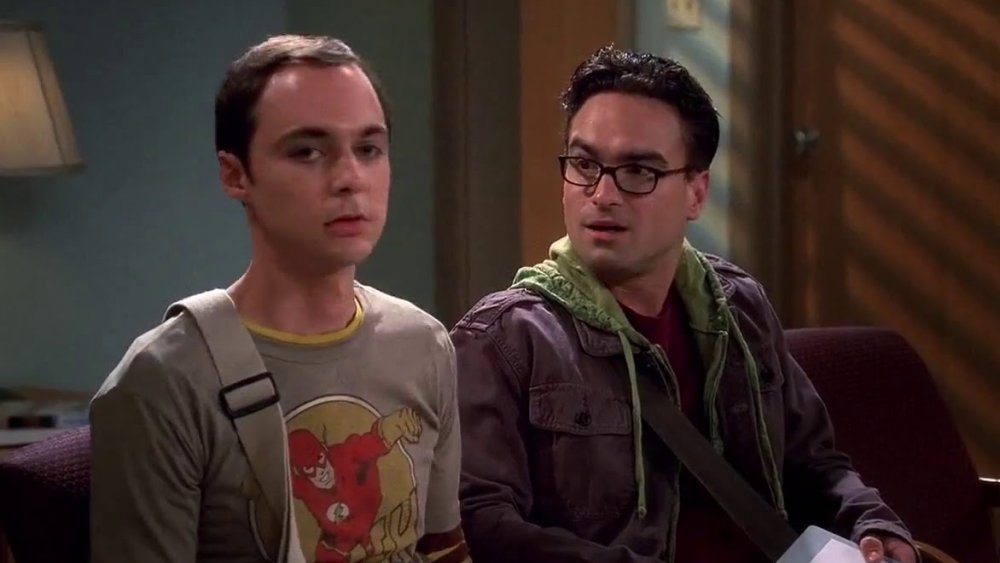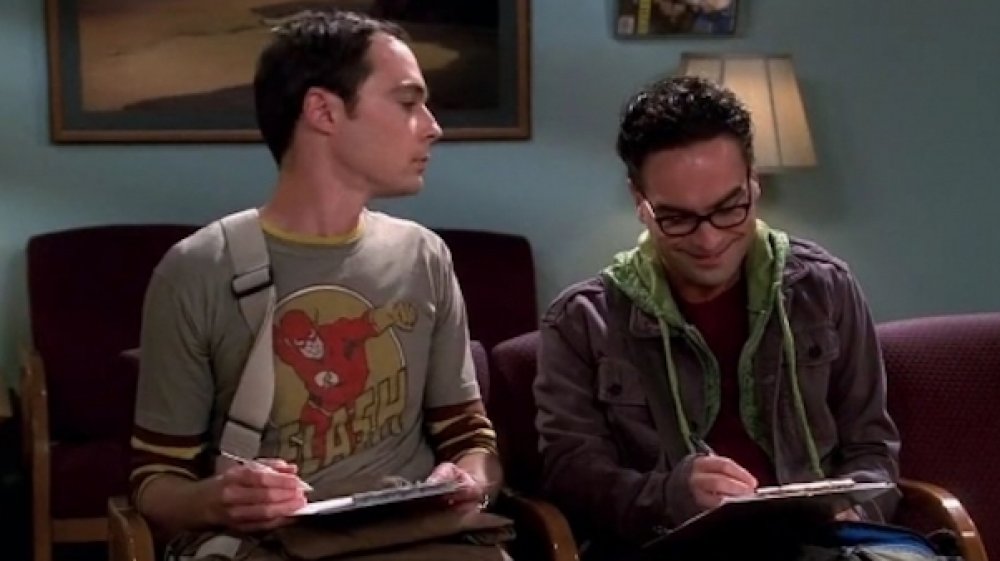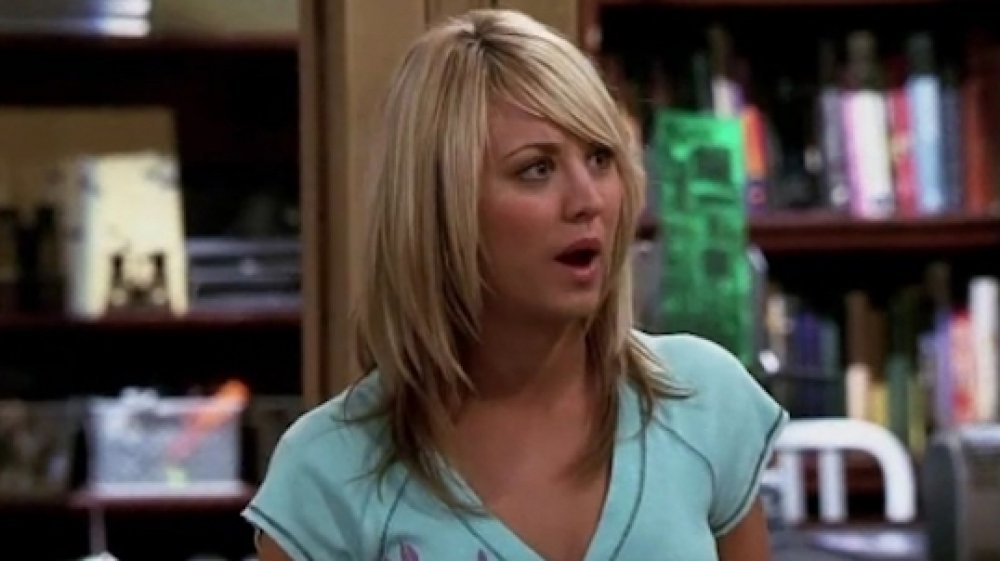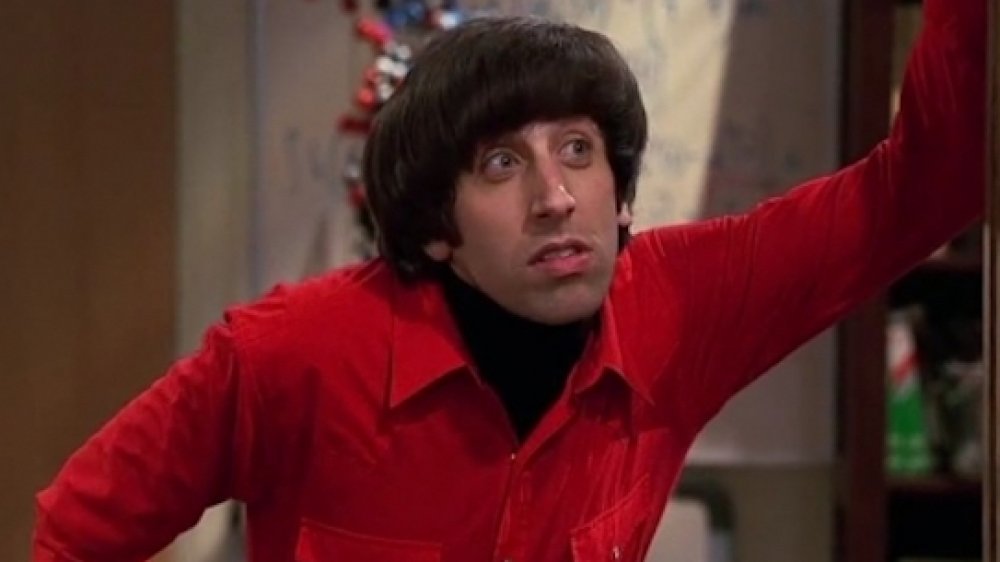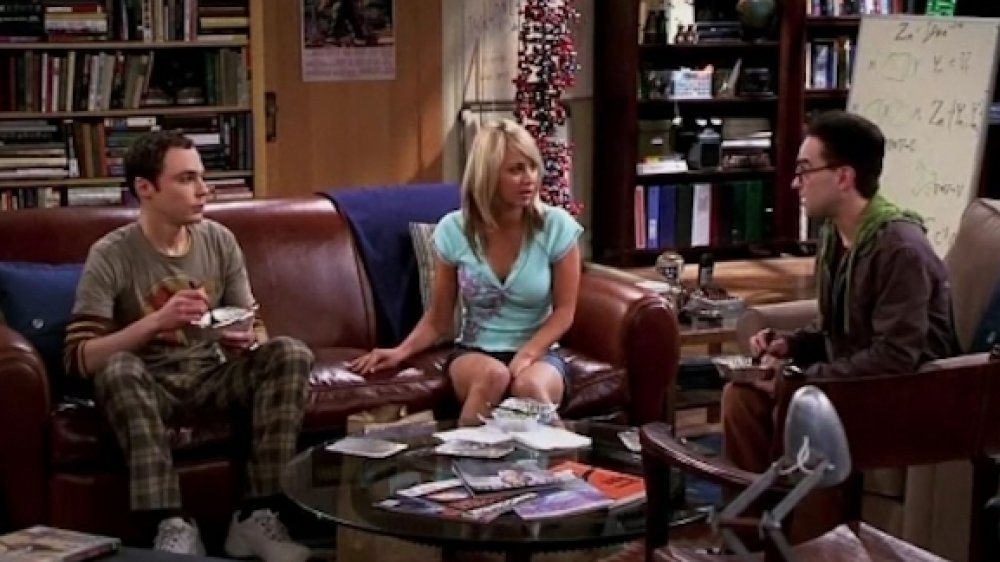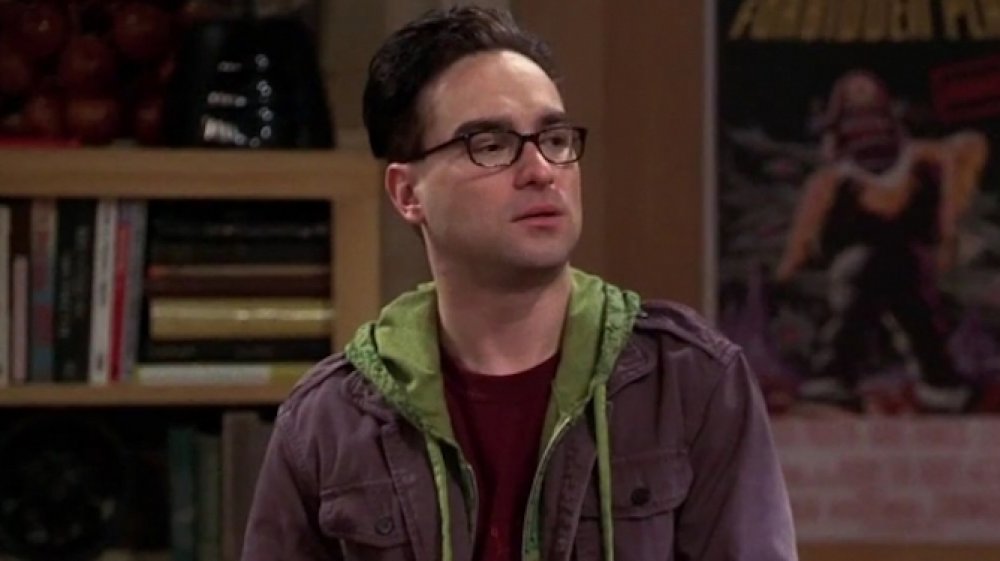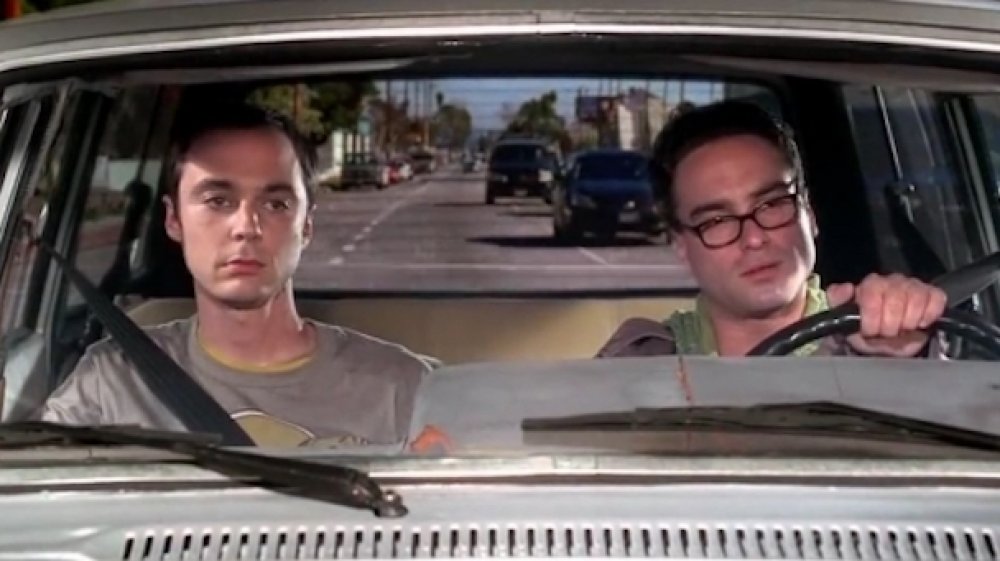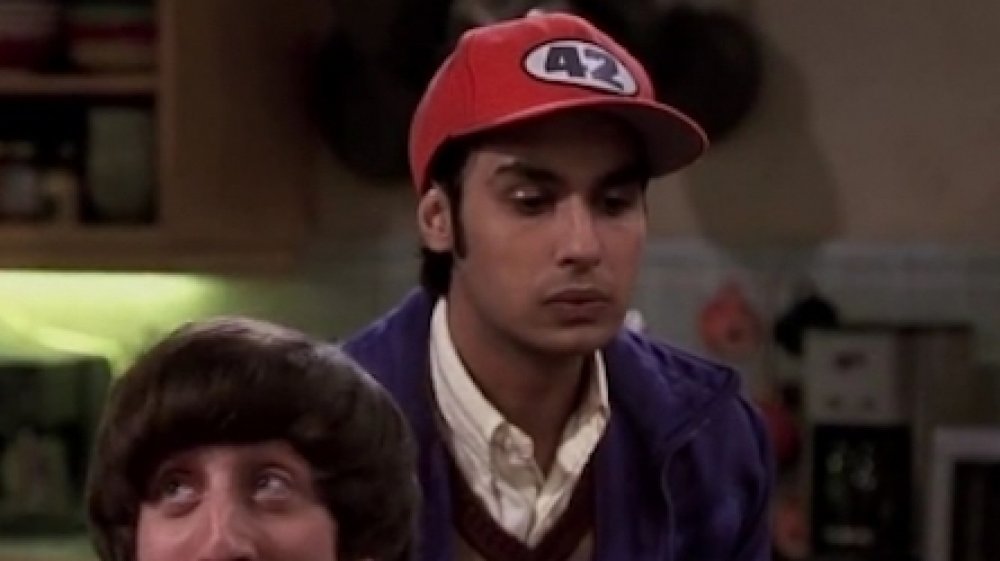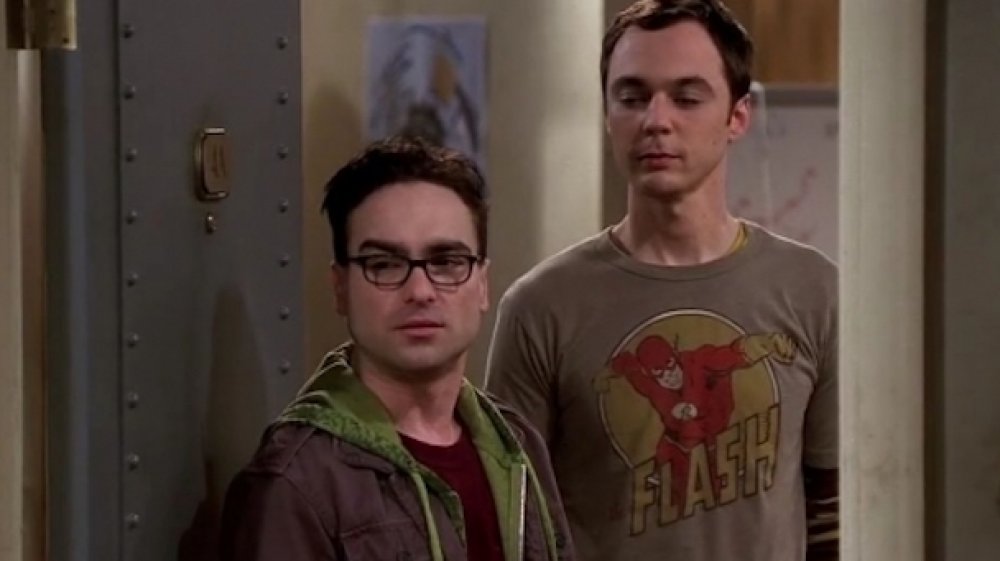Things You Never Noticed In The Big Bang Theory's First Episode
So many episodes of The Big Bang Theory were produced — 279, the most ever for a live-action, multi-cam sitcom — and they air so frequently in reruns that the series has become a cultural blanket. Episodes are so familiar that they can be background noise, a friendly presence on the TV while cooking dinner. And apart from where Penny and Leonard are in their relationship, there aren't many signifiers to the audience as to where in the show's 12-year run that episode was made.
None of that is true for the very first episode of The Big Bang Theory, however. On the surface, it looks like a regular installment — Sheldon is arrogant and wears a comic book character TV shirt, and Leonard sports several layers and is already pining for Penny — but upon closer examination, it's an aberration in the huge Big Bang canon. It takes a show a while to get the kinks out, and this one is no exception. Here are all the weird things you might not have realized about the first episode of The Big Bang Theory.
Sheldon wasn't distinctively Sheldon in The Big Bang's Theory first episode
The first scene of the first episode of The Big Bang Theory begins with a setting never seen on the series again and broaching a topic never approached further. Concerned about growing old before passing on their science genius genes, Sheldon and Leonard visit a sperm bank — one that only accepts the genetic material of the highly intelligent and exceptional. While that's very much in character with Sheldon's outspoken vanity and pride in his superior intellect, it clashes mightily with how he's depicted for most of the rest of the series, which is as an individual averse to any and all kinds of sexual and physical behavior. It's a little weird to see the almost always libido-free Sheldon — who takes years to kiss eventual girlfriend Amy, let alone go any further — openly talk about and be open to providing a sample at a sperm bank. It's even stranger later in the episode, when the legendarily awkward and game-free Sheldon considers the possibility of coupling up with Penny.
Penny's spirit wasn't broken yet
Similar to how Sheldon is more of a red-blooded sexual being than he'd wind up for most of The Big Bang Theory, Penny isn't quite right at the beginning of the show. She moves in across the hall from Leonard and Sheldon, and the former is smitten with her after their first meeting. Sure, she's conventionally attractive, but Penny is also very likable. She's friendly, she's bubbly, and she's curious about her new building-mates. This isn't the Penny that Kaley Cuoco would play on the way to fame and fortune. Before long, Penny would get a lot less lively and a lot more cynical, as ready as anyone else with a cutting, sitcom-style put-down or eye-roll. Perhaps hanging out with all those fussy, exhausting, high-maintenance nerds day in and day out killed her spirit, along with that tiring job as a chain restaurant waitress and a demoralizing, ultimately failed career as an actress.
And far from just the stereotypical dumb blonde archetype she's supposed to embody, Penny reveals in episode one that she's written a screenplay about a girl from Lincoln, Nebraska, who moves to Los Angeles to be an actress but winds up waitressing. (It's not autobiographical, she says, because she's from the Omaha area, not Lincoln.) There's no mention further in the series of Penny's potential double-threat as a performer and a writer, and her screenwriting "talents" were quickly abandoned.
Where is everybody?
Maybe the most noticeable thing about the first episode of The Big Bang Theory isn't what's there but what isn't there ... or rather who isn't. Nearly half of the show's core, long-term cast members weren't yet a part of the series. Kevin Sussman didn't make his first appearance as sad-sack comic store owner Stuart until the end of season two, Melissa Rauch didn't join the series as microbiologist Bernadette Rostenkowski until the start of season three, and Mayim Bialik didn't portray neurologist Amy Farrah Fowler until the end of season three. That means none of them show up or even merit a mention in the first episode of The Big Bang Theory.
As a result, that gives the proceedings a sparse feel. It's just really quiet and simple with only five main characters — three if you don't count the virtually silent Raj and Howard Wolowitz, something of a one-note character, in which the one-note is "creepy lech who tries too hard to attract Penny." Furthermore, after so many episodes about romantic entanglements — Sheldon and Amy, Howard and Bernadette, Leonard and Penny — it's the rare and glaring episode of The Big Bang Theory not totally about coupling.
The first episode of The Big Bang Theory moves really slowly
The Big Bang Theory could be characterized as a quick-moving, rapid-fire show. The setups and punchlines come at the viewer fast, as do scene changes with that distinctive transitional graphic of an atomic model accompanied by a "whoosh" sound effect. Plus, the average Big Bang episode incorporates a lot of scenes at several locations, generally including the main apartment set, the one across the hall, some CalTech offices, the cafeteria, Howard and Bernadette's house, and a few other spots.
However, that format and its fast flow weren't in place in the first episode. The pilot feels more like a play, clearly separated into three acts and only a handful of scenes, and they're all about as long as a scene can be in a half-hour sitcom. The episode begins with a pre-theme song "cold open," in which Sheldon and Leonard head into a sperm donation clinic and have a long, meandering conversation, which serves to introduce the characters to the audience. It's a whopping six minutes long. After that, it's on to the guys' apartment, where the vast majority of the episode takes place.
It was unequivocally taped in 2007
Most episodes of The Big Bang Theory don't place themselves into any specific time period. It's not like Mad Men, loaded with references to establish what month in the '60s it's set, or Murphy Brown, with its constant contemporary news references. Rather, The Big Bang Theory takes place in sitcom land, a place detached from reality. (The offer of escapism is certainly a big part of the show's appeal.) Even the references from the show's pop culture-devouring nerds are evergreen and accessible. For example, Sheldon and Leonard are much more likely to discuss chestnuts like Star Trek and Star Wars than early 2010s sci-fi shows like Dollhouse or Orphan Black.
However, establishing that "set apart from time" vibe took, well, time, and the first episode is full of jokes and references that squarely — and awkwardly — place it firmly in late 2007. For example, Sheldon expresses his enthusiasm for watching the then-recent Battlestar Galactica reboot on DVD ... with commentary. That was a nearly dead delivery format by the time Big Bang ended in 2019. In another moment, Sheldon brags about his social circle, in that he has 212 friends ... on the soon to be widely abandoned MySpace.
Some jokes didn't age very well
Not only do the cultural references frame the first episode of The Big Bang Theory as a weird relic from the now ancient year of 2007, but so do a few of the jokes. If this episode were taped now — in a decidedly more socially conscious, considerate, and woke era — a couple of gags from the script wouldn't make it to the final cut. And if they did, there would be a Twitter storm over their crassness and insensitivity.
Back in 2007, it was still culturally acceptable to make jokes at the expense of the LGBT+ community, and the first episode of The Big Bang Theory unfortunately took advantage of this. For example, with her front door open, Leonard sees Penny for the first time and remarks that she's a "significant improvement over the old neighbor." Sheldon agrees, as the previous tenant was "a 200-pound transvestite with a skin condition." Moments later, Leonard makes great, tedious pains to ensure that Penny doesn't get the wrong idea and think that he and Leonard are a couple. "We don't live together," he asserts. "We live together but in separate, heterosexual bedrooms."
Raj isn't quite fleshed out yet
Based on his behavior in the first episode of The Big Bang Theory, it's hard to get a handle on Raj Koothrappali (Kunal Nayyar). No trace of his future character arcs are present — not his desire for a grand and epic romance, nor his slow acceptance of his own fate and his move away from dependence on his wealthy parents. That's because Raj, a main character in most episodes of The Big Bang Theory, has about two lines in the show's pilot episode.
That's explained away with his early quirk of being too shy to talk to women (such as Penny) without the aid of alcoholic beverages, but still, it's odd and surprising that he barely talks. Raj even dresses differently, wearing a baseball cap with his regular nerdy outfit. However, the hat is adorned with "42," a nice geeky Easter egg, as that number is "the ultimate answer to life, the universe, and everything," according to Douglas Adams' sci-fi classic The Hitchhiker's Guide to the Galaxy.
The first episode of The Big Bang Theory has some parallels to the finale
Although many ingredients that would make The Big Bang Theory such a resounding, long-running success weren't yet present in the show's first episode, the writers did show some foresight. Like other situation comedies about groups of young friends — Friends, How I Met Your Mother — The Big Bang Theory is about a social group that forms a de facto family, and it evoked that idea week after week by having the whole gang gathering to eat together, like a family dinner. It was a powerful statement, and the cast eating takeout with one another became one of the definitive, enduring images of The Big Bang Theory. It was also the very last scene of the very last episode of the series, creating a parallel with the first episode, where Sheldon and Leonard invited Penny into their family by asking her to eat with them.
Plus, in the pilot episode, Leonard watches Penny walk away, and then he proclaims they will one day have babies that "will be smart and beautiful" thanks to their meshed genes. In the finale, married Penny and Leonard learn they've got a baby on the way. "I was there the moment Leonard and Penny met," Sheldon calls back during his Nobel Prize acceptance speech. "He said to me that their babies would be smart and beautiful. And now that they're expecting, I have no doubt that that will be the case."
